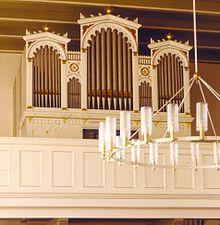Mittegroßefehner Church
The Evangelical Lutheran church in Mittegroßefehn is located in the district of the same name in the East Frisian community of Großefehn . It was inaugurated on January 7, 1857 and shows styles of neo-Romanesque , neo-Gothic and classicism .
history
The history of the settlement of Großefehn began in 1633 when four Emden merchants began building a canal to drain the moorland in what is now Westgroßefehn. This village continued to expand and around 1760 reached the eastern border of the settlement area of Mittegroßefehn. In 1848 a cemetery was laid out on Schrahörn-Strasse and an assistant preacher was employed to hold services in a room in School II, which was specially enlarged for this purpose. The community has been independent since 1857. A year earlier, on the initiative of Pastor Johann Heinrich Leiner , the construction of today's church began in the middle of school communities II and III on Sandhöchte, the highest point in the village. The steeple is a little younger than the church, but still in the same architectural style. King George V made its construction possible in 1865 with a donation.
description
The Mittegroßefehner Church is a hall building with raw brick masonry. Their appearance is characterized by the neo-Romanesque . Its outer walls are structured by fields formed from pilaster strips with round-arched, ornamented windows with iron tracery. The south side has five windows, the north side four. In the east, the building is completed by an attached semicircular apse with three circular, ornamented windows above the altar. The main entrance is on the ground floor of the retracted bell tower in the west. This has three storeys and is covered with a gable roof.
Furnishing
The interior of the church is designed in the neo-Gothic style and finished with a flat beamed ceiling at the top. The font and pulpit date from the time the church was built and were created in 1857. The altar is in the neoclassical style and fills the entire apse . At its center is a representation of Christ. The top of the church tower is the three-masted schooner Queen Marie , named after the wife of King George V of Hanover. It was carved out of a copper plate, is 1.35 meters long and 0.9 meters high and is a reminder of the many seafarers who lived in the community at the time the church was built. The church utensils, consisting of jug, chalice, ciborium , paten and medical utensils, as well as the silver-plated baptismal bowl, were donated in 1873.
Brond de Grave Winter built an organ with 13 registers on two manuals and a pedal in 1859/60 . After the prospect pipes for armaments had to be delivered during the First World War (they were later replaced by zinc pipes) and an overhaul in the 1970s was unsustainable, the organ was closed in 2004 because of its unsustainable poor condition and the hopelessness of financing the necessary thorough repairs shut down indefinitely. Instead, the community acquired an electronic organ from the Johannus company that has sampled organ pipe sounds . Your loudspeakers were placed in the organ case on the floor so that the sound comes from the organ as usual.
See also
literature
- Hans-Bernd Rödiger, Heinz Ramm: Frisian churches in Auricherland, Norderland, Brokmerland and in Krummhörn , volume 2. Verlag CL Mettcker & Sons, Jever (2nd edition) 1983, p. 37.
Web links
- Church district Aurich: Mittegroßefehn
- Siegfried Lüderitz (local chronicle of the East Frisian landscape ): Mittegroßefehn (PDF file; 58 kB)
- Genealogy forum: Mittegroßefehn
Coordinates: 53 ° 23 '39.2 " N , 7 ° 33' 59.8" E


